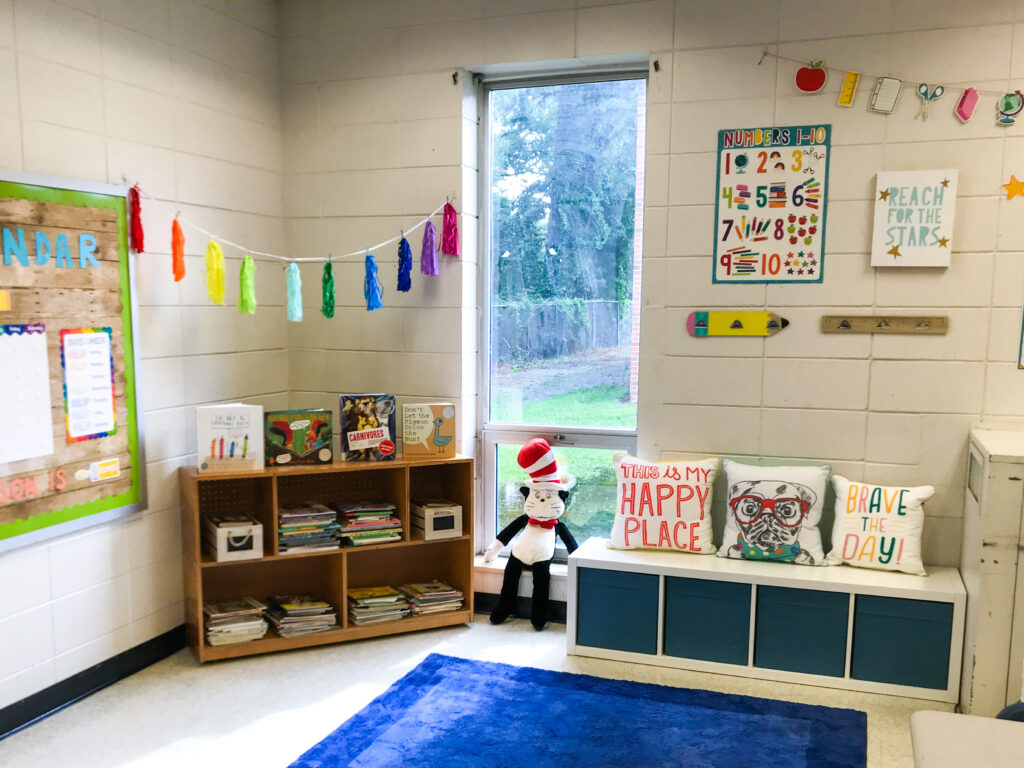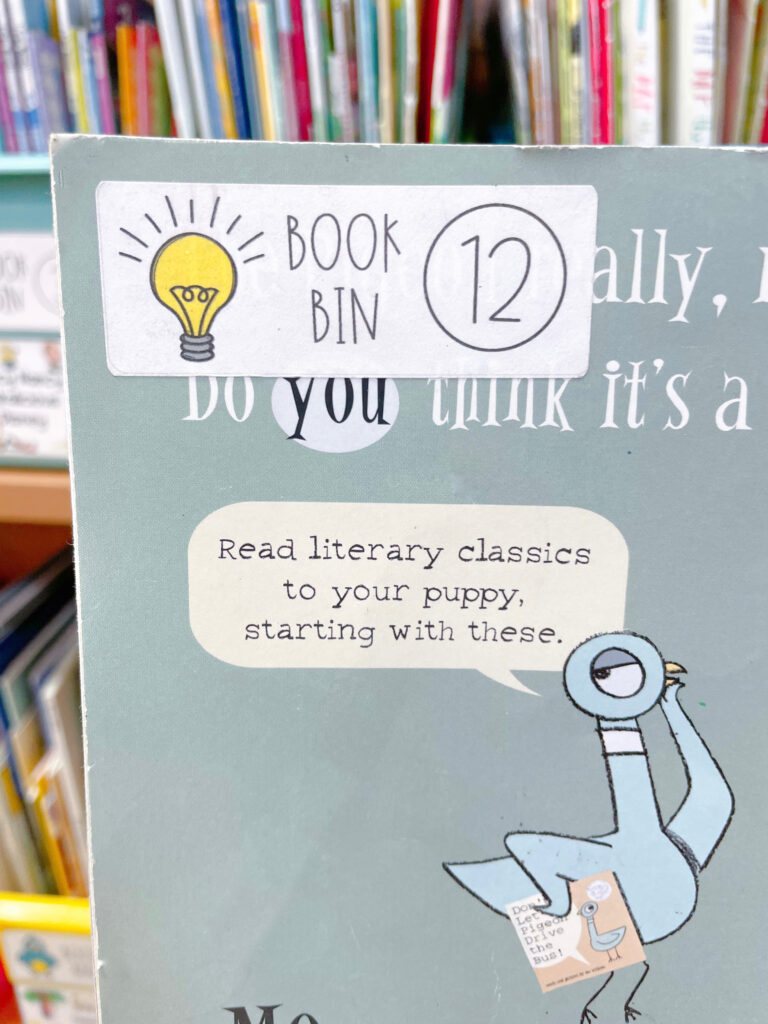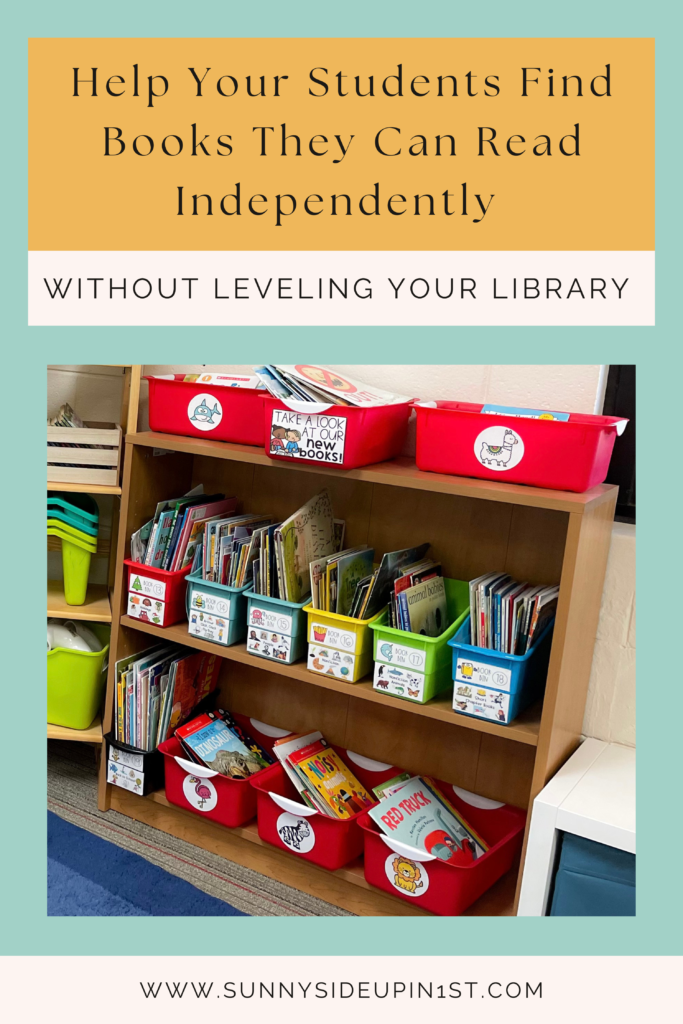If you’re an elementary teacher, chances are you either love or hate class library organization. Setting up your classroom library can be so much fun, but it can also be overwhelming and time consuming, especially as a newer teacher. I spent years finding the perfect way to organize all of the books in my first grade classroom, and it turned out to be the easiest method that required hardly any maintenance from me!
Before I tell you all about this simple classroom library organization system, make sure you’ve grabbed my free guide to quick and simple student engagement strategies. Just like this library system, the guide is EASY. It will also give you tons of ideas that you can start using in your classroom today. Click here to get it sent to your inbox!
My First Classroom Library Set-Up
As a first-year teacher, I remember being overwhelmed with all the things on my to-do list. I needed to set up my classroom, figure out curriculum, write a classroom management plan, and so much more. I had a big box of books that I had accumulated, but no idea how to set up a classroom library, and that task ended up getting pushed to the bottom of my list. For the first few weeks of school, this is what my library looked like.

When I finally got around to buying book bins and sitting down to think about some organization, it seemed like everyone sorted their books by reading level, so I did the same. This made my library look neater and worked fine for the year, but it wasn’t very helpful for my students being able to find the books they wanted to read. When I began my second year of teaching, I knew I wanted to find a better system.
Why Is Class Library Organization Important?
Whether it’s your first or twentieth year teaching, you’ve probably had a similar experience of either not knowing how to set up your library, or feeling like you don’t have the time or energy to do it. It can be such a big project! Taking the time to create an inviting and well-organized library area is so important because it shapes the reading experiences that your students will have throughout their year with you. Students need a simple system in which they can easily access the books they want to read, as well as discover new books. Providing this type of system will ultimately increase your students’ exposure to books and enjoyment of reading!

How to Organize Your Classroom Library in the Easiest Way Possible
Okay, so HOW should you organize your class library? Over the past four years, I’ve developed a system that is so simple and effective for young students to use, and I’ll walk you through each step of it. Depending on your students’ age and the resources you have, you may need to adapt to fit your classroom needs. As a whole, this system is best suited for pre-k through third grade. My hope is that reading through these steps will inspire you to think about how you can make class library organization easier for both you and your students!

Sorting Your Books into Bins
In order to use this set-up, you’ll need some book bins – any type works! I have about twenty, but you’ll be able to work with what you have, and you can always get more later. The beauty of this system is that it’s SO flexible. Start by thinking about what books you have in your classroom library and how you want to sort them. I like to lay all my books out on tables and actually stack them in groups so I can see about how many books will go in each bin.
Depending on how many bins you have, decide how you’ll group your books – maybe by genre, author, or topic. I like to do a mix of the three. I also keep several of the bins fairly generic so it’s easy to find a home for new books later. Some examples of my bin titles are “Nonfiction Animals”, “Favorite Read-Alouds”, “Clifford, Froggy, and Henry and Mudge”, and “Holiday Books”. If you have books that don’t fit perfectly in a category, that’s okay! Think about where they fit most closely or broaden the category, like “Silly Animal Books”.

Labeling Your Book Bins
The next step is to label your bins clearly so that students know exactly where to find the books they want to read. In order to do this, I label my bins in two ways. The first is with a simple number/picture label. I assign each bin a number to make it as easy as possible for students to put back books. Along with the number, I also include a picture. The picture is especially helpful for quick recognition with younger students.
While the number/picture label is the easiest and most effective way I’ve found to keep my library neat and organized, it doesn’t tell students what books are in what bins. So, I also include a topic label that tells kids in words and pictures what kind of books they can find in the bin they’re looking in. To make these labels, I start by typing out the bin title in the center of the label. This may or may not include EVERY book that’s in the bin, but it will give the general topic, author, or theme. Then, I search for pictures that will give students a clear visual understanding of what’s in the bin. I drag and drop those pictures around the title on the label. Tip – add “png clipart” to the end of your search term to find clear pictures without backgrounds.

Another option is to have your students decorate the bin labels! This way, they are invested in the process and can feel proud of seeing their work around the classroom.
How to Label Classroom Library Books
After you’ve labeled your bins, you’ll want to have some way to label your books. This is the most efficient way I’ve found to help students know exactly where to put their books back. I like to use Avery labels so that I can make the book labels exactly match the number/picture bin labels. This way, students of any age can take a quick look at their book and find the bin that correlates.

Another option to label your books, especially if you want something smaller, is to use garage sale-type stickers and simply write the number of the book bin on there. However you choose to label, consider the placement of the stickers on the books. I like to put mine on the backs of the books so they don’t intrude on the cover, but are still easy to find. Other options are the front cover, front inside flap, or back inside flap.
Ways to Organize Your Classroom Library to Include Leveled Books
When I started really digging into effective class library organization, I found so much research on why books should be organized by topic/genre/etc. and not by level. Students, especially struggling readers, should be encouraged to find books that they truly love and want to read, not books “at their level”. With that being said, some students need help finding books that they are capable of reading independently. Other students want to be able to locate books that aren’t too hard or easy for them. Here are a few things I do to help with that.
Classroom Library Set-Up to Support All Readers
First, I dedicate four of my book bins to the following titles: “Step One Readers”, “Step Two Readers”, “Step Three Readers”, and “Short Chapter Books”. When students look in these bins, they know exactly what type of book they are getting. However, they aren’t feeling like they “have” to read that book because they can’t read other books.
Another way I help students find books that they can read independently or mostly independently is through group book bins. Most years, I have five reading groups in which students are grouped by their reading level – flamingos, zebras, sharks, lions, and llamas. In our library, I have one bin dedicated to each group with a picture of their animal on the front. Each bin holds a variety of books that those students can read independently or with a little help, and I trade these books out frequently throughout the year.
On Fridays, students go book shopping for the following week. At this time, they choose two books from their group bin and two books from anywhere else in the library. This way, I make sure that students have books in their book bags (which they take home each night) that they can read mostly on their own, but they also have the freedom to choose any other books that they want.

Finally, if I know the guided reading level of a book, I put a sticker with that letter on the back inside flap of the book. This is simply for my knowledge and to help me with easily trading out books in group book bins. My students rarely notice or ask about these stickers, but if they do, I just tell them the letter can help them if they’re looking for an easier or harder book.

Other Classroom Library Ideas
I hope this is getting your wheels turning with class library organization ideas that will make your classroom more student-friendly! Here are a few more ideas to really make the most of your library corner.
Get Your Students Organizing Your Classroom Library
When you introduce your library at the beginning of the year, be sure to model, model, and model again how to use it! I spend a lot of time showing students exactly how to find the books they’re looking for and put them back neatly in bins. Interactive modeling is a great way to do this (if you haven’t used it before, Google it – it’s simple but so effective). Throughout the year, we revisit class library expectations, especially if I notice students putting books back sloppily. I also have two library helpers each week who are in charge of tidying up the book bins every afternoon. These students check for books that were put back backwards or in the wrong bins, and straighten everything up so that it looks nice. Because of these systems, I hardly have to do anything for library maintenance!

Building Excitement for New Books
Helping my students love reading is one of my favorite and most important parts of being a teacher. Any time we get new books in our classroom, I make a big show of revealing them to the kids one at a time and getting them excited to read them. Sometimes, I save one or two of them for a special read-aloud and make the kids wait to hear them. I also like to do random drawings to see who will get to take home the books first. Once I’ve revealed our new books, I put them in a special bin with a “Take a Look at Our New Books” sign (a freebie from Creatively Teaching First’s TPT store) so students know exactly where to find them. They always go straight for these books and it makes me so happy!
My Classroom Library Organization System
My hope for you is that this post has given you some ideas to organize your classroom library in a way that supports your students and makes your life easier. If you’d like to use my book bin labels and book stickers in your classroom, you can find everything I use in my own library here. This resource includes 30 bin labels, 30 sheets of matching book stickers, editable numbered bin labels, book stickers, and topic labels, and directions to help you set everything up!
If you have any questions at all about this library system, please feel free to send me an email at mary@sunnysideupin1st.com or message me on Instagram. I’d love to help you figure out how to make your class library organization even better!

